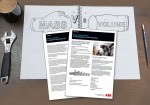Picking the best valve for the job
Published: 18 May, 2016
Valves aren’t necessarily the most exciting tool in any building’s toolkit, but whilst unseen and unsung, valves are not only heroes in their own right but absolutely vital to make any building management system run smoothly. Simon Garratt, marketing manager, field devices, at Schneider Electric, reports.
People think of valves as tools which makes things stop and go – but they are so much more than that. They also control flow by regulating pressure and, importantly for some applications, they prevent backflow.
Valves sit behind walls, in basements and mechanical rooms, or in other out-of-sight places. Hiding away such infrastructure allows elements like heating, ventilation, and air conditioning (HVAC) systems to run smoothly. Adjust a thermostat and hot or cold air comes pouring out of a duct, the temperature of a room changes, and not only is everyone within that building more comfortable, but also more productive, according to the World Green Building Council.
So, how do you go about selecting the right valve for the job? First, consider the operating conditions, then take a look at the valve materials and the valve type. As far as conditions go, you’ll need to start by answering some basics like whether you’re handling liquids or gases, or whether the solution you’re handling is corrosive or explosive? Then you need to look at the purpose of the valve – is it going to be a simple on/off valve, throttling or for preventing backflow?
The materials valves are made from can vary depending on operating temperatures and pressures, ranging from the familiar, like steel or plastic, to the exotic, like refractory metals and ceramics. Unless you have some unusual requirements, such as handling white hot gases or liquids, the materials will tend be plastic, bronze, iron or steel.
So, how do you go about selecting the right type of valve for the job? Ball valves, for example, have a smooth and unobstructed flow path, so they can handle viscous fluids and slurries. Ball valves are well suited to shut-off applications, cases where flow is either completely on or off.
Globe valves, on the other hand, are good for throttling applications. The internal movement of the fluid flow leads to a considerable pressure drop, though. This should be kept in mind if it is important to your application.
Butterfly valves are useful in throttling applications where a larger valve is needed. A disc sits inside the valve, with this rotated to be either completely blocking flow, minimally impacting it or somewhere in-between. It is important when considering a butterfly valve that you look at all materials used within it. The liners, for instance, are important for sealing and so must be able to handle the temperature and pressure.
For most heating, ventilating and air conditioning (HVAC) systems or heating/domestic water applications, either a ball or globe valve will be suitable.
An example of the impact new technology can have have on valves is found in the latest pressure independent control valves, or PICVs. These devices combine control and balance valves into one, saving both installation time and cost. Because one PICV replaces two or three older devices, commissioning and installation time is reduced. Newer technology – and fewer devices – means that seals are tighter and there is less energy seepage.
Beyond the valve itself, look for such factors as simplicity, efficiency and cost effectiveness of operation. Also, it is best if the designs are interchangeable. That’s because when a system is being designed and deployed, it may seem that a simple on-off operation is all that’s needed. However, at some point, it may be better instead to have the ability to throttle flow from a maximum to a minimum, adjusting it as desired. If valves are interchangeable, then the switch is as simple as swapping out a gate valve for a ball valve.
So, start with the operating conditions, consider the material and finally take a look at the valve type. Do that, and when you have to go with the flow, you’ll have the right valve for the job.
For further information please visit: www.schneider-electric.com





 A new information pack is now available from ABB said to help simplify the selection of flowmeters for process applications. Featuring a White Paper, application guide, webinar presentation and video, the pack explains the key differences between volumetric and mass flow methods and how to choose the right method for industrial process applications.
A new information pack is now available from ABB said to help simplify the selection of flowmeters for process applications. Featuring a White Paper, application guide, webinar presentation and video, the pack explains the key differences between volumetric and mass flow methods and how to choose the right method for industrial process applications.
